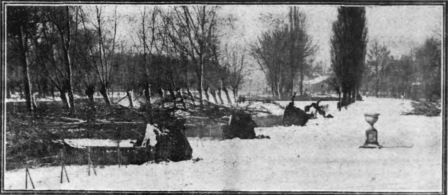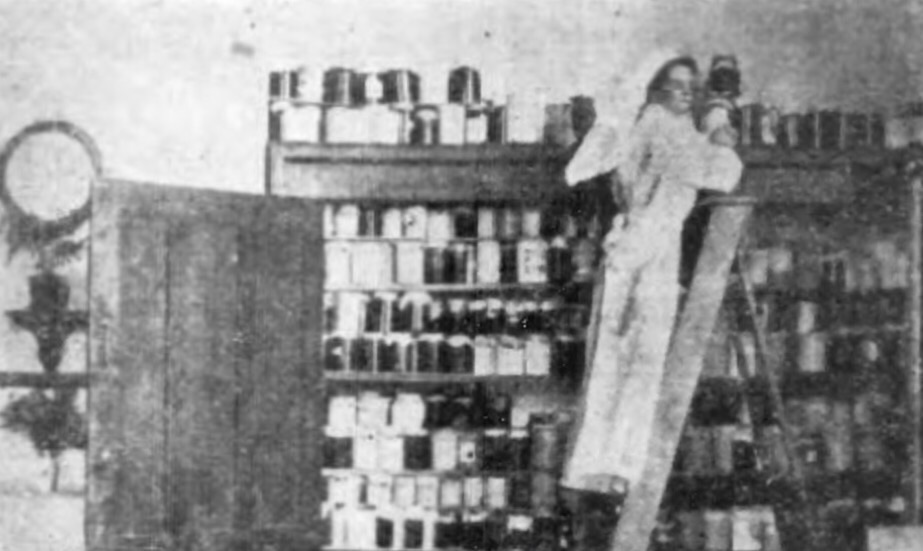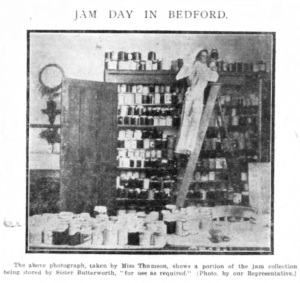Storms have names now and in recent months have been battering the United Kingdom with monotonous regularity.
One hundred years ago an anonymous storm raged over the country on 27 and 28 March 1916, the ‘Great Blizzard’ said the Bedfordshire Times and Independent in its headline. ‘Gusty Boreas had his fling on Monday night and Tuesday’, readers were informed, ‘and wrought havoc over all the country.’
The reporter was even moved to quote Virgil ‘Ac venti, velut agmine facto, qua data porta runt, et terras turbine perflant’* which you don’t come across too often today in weather reports.
According to the paper ‘Biddenham felt the full force of the gale. Many houses were flooded out, and about 150 large elm and fir trees were blown down. Telegraph wires lay in all directions along the Bedford Road. The watercourse has overflowed its banks, and inundated a large area near Queen’s Park schools, and the allotment holders in Cox Pits expected a big flood.’
Villager Albert Church, a schoolboy in 1916, recalled the aftermath of the storm in his 1979 memoirs. Soldiers billeted in the village at the time (who would have been from the 68th (2nd Welsh) Division) provided manpower and horses to cut up and shift the fallen trees, work which took days. The children were sent home from school after one of two elm trees next to the school blew down, just missing the school playground. Nothing could get in or out of the village by road and farmers had to go through fields with their pony and float to get the milk to market. Albert said how lucky villagers were to have a shop and a baker in the village.
(Soldiers from the Division helped clear up the debris left by the storm in other Bedfordshire villages, and may have helped too in Bedford itself.)
The newspaper lamented the lack of night-time illumination in the town ‘Belated wayfarers were almost blinded by the blizzard on Monday night, and the weather was then pronounced, by those who experienced it, the worst they had ever experienced, but it might have been a little more endurable in the streets of Bedford if the lamps had been lighted as they might very well have been for all the risk there was of air-raid, where no air-craft could have lived for ten minutes.’
If Monday night had been bad, Tuesday was worse. From two o’clock on Tuesday afternoon the rain, which had taken over from Monday’s snow, turned into another snowstorm which ‘developed into a hurricane of well nigh unparalleled violence in this country’ and although the snowstorm subsided by six o’clock the ‘boisterous wind’ continued until about nine. ‘An alarming experience was the crash of falling trees on the Embankment and in St Peter’s.’
As well as the felling of trees and telegraph poles and wires, there was widespread damage to buildings, and ‘One driver of a M.R. van tells the story of how the blast caught him and his horse and van on the Embankment, and when it had done with them he found his horse trotting in the opposite direction!’
Rail travel was affected with snowdrifts of four feet deep reported between Bedford and Northampton and up to ten feet deep at the side of the track.
‘At quite an early hour’ the newspaper said ‘large numbers of wood-pickers, not woodpeckers, arrived in Newnham Lane, and prams, mail-carts, bags and baskets were soon filled with twigs and heavier portions of the fallen trees.’ “It’s an ill wind that blows nobody any wood” the reporter commented.
The newspaper reported extensively on the damage and deaths across Bedfordshire from the storm. This was, however, not the first storm of 1916 for the newspaper added that ‘Tuesday afternoon’s storm laid low even trees which the violent hurricane of New Year’s Day had spared.’
In its next edition, on 7 April, the newspaper printed several photographs of the damage, taken on the morning of 28 March. The featured picture above shows wood-picking children in Newnham Lane out to ‘keep the home fires burning’ and the picture below shows four fallen poplars on the Embankment:

*Translations have moved with the times:
‘The winds, as in a formed battalion, rush forth at every vent, and scour over the lands in giddy whirls’ or if you prefer:
‘And the wind, just as when a battle line has been made, where any door was given, they rush and blow over the land in a whirlwind’ or, if you can remember your Latin, try your own!






